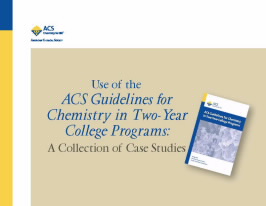Case Studies
How Institutions Use the Guidelines
The ACS Guidelines for Chemistry in Two-Year College Programs were developed to provide a model of excellence for a broad range of programs, goals, and institutional missions. The Use of the ACS Guidelines for Chemistry in Two-Year College Programs (PDF) is a collection of case studies that highlight how individuals have used the Guidelines to strengthen chemistry education at their institutions.
The Guidelines have been used to simultaneously:
- Overhaul chemistry education and develop a new biotechnology program (example)
- Ensure alignment among courses at two- and four-year colleges (example)
- Redesign science laboratories (example)
They have been implemented at both small and large institutions in a variety of settings.
Read case studies by:
Case Studies by Topic
| Topic | Case Study |
| Laboratory or classroom design | |
| Acquisition or updates of equipment and other resources |
|
| Program, curriculum, or course development |
|
| Program self-assessment | |
| Enrollment limit | |
| Partnership development | |
| Faculty policies, hiring, and professional development |
Case Studies by Campus Size/Number of Faculty
The size of the campus is denoted by the total Fall 2010 enrollment, as reported by the U.S. Department of Education’s Integrated Postsecondary Education Data System (IPEDS).
The number of full-time chemistry faculty is for Summer and Fall 2011, as reported by the faculty who provided the content for the case studies.
< 5,000 students
- Lake Michigan College, Benton Harbor, MI
Full-time chemistry faculty: 3 - State Fair Community College, Sedalia, MO
Full-time chemistry faculty: 1 - Western Piedmont Community College, Morganton, NC
Full-time chemistry faculty: 3 - West Shore Community College, Scottville, MI
Full-time chemistry faculty: 1
5,001-10,000 students
- Cerro Coso Community College, Ridgecrest, CA
Full-time chemistry faculty: 1 - St. Charles Community College, Cottleville, MO
Full-time chemistry faculty: 3 - Yavapai College, Prescott, AZ
Full-time chemistry faculty: 3
10,001-20,000 students
- College of the Canyons, Santa Clarita, CA
Full-time chemistry faculty: 5 - Minneapolis Community & Technical College, Minneapolis, MN
Full-time chemistry faculty: 4 - Santa Fe College, Gainesville, FL
Full-time chemistry faculty: 3 - Scottsdale Community College, Scottsdale, AZ
Full-time chemistry faculty: 4
20,000 students
- Salt Lake Community College, Salt Lake City, UT
Full-time chemistry faculty: 5
Case Studies by Type of Community Served*
The type of community served is defined according to the U.S. Department of Education's categories.
Rural
- Cerro Coso Community College, Ridgecrest, CA
- State Fair Community College, Sedalia, MO
- West Shore Community College, Scottville, MI
- Western Piedmont Community College, Morganton, NC
Suburban
- College of the Canyons, Santa Clarita, CA
- St. Charles Community College, Cottleville, MO
- Salt Lake Community College, Salt Lake City, UT
- Santa Fe College, Gainesville, FL
- Scottsdale Community College, Scottsdale, AZ
Small City and Urban


